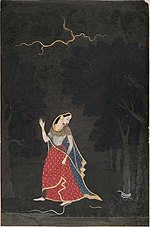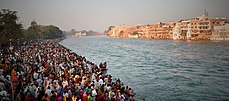 Culture and people are very closely associated with each other. The term ‘culture’ refers to the complex collection of knowledge, folklore, language, rules, rituals, habits, lifestyles, attitudes, beliefs, and customs that link and give a common identity to a particular group of people at a specific point in time.
All social units develop a culture. Thus it is the inhabitants of a specific region that collectively contribute to form that extraordinary cornucopia of life we call culture.
Culture and people are very closely associated with each other. The term ‘culture’ refers to the complex collection of knowledge, folklore, language, rules, rituals, habits, lifestyles, attitudes, beliefs, and customs that link and give a common identity to a particular group of people at a specific point in time.
All social units develop a culture. Thus it is the inhabitants of a specific region that collectively contribute to form that extraordinary cornucopia of life we call culture.
In case of Uttarakhand, the Land of Gods, natural diversity and the element of the Himalaya’s unparalleled beauty and sanctity add a new dimension to the word ‘culture’. The people of the state are as diverse as the landscape. Uttarakhand is blessed with a whole multiplicity of culture greatly influenced and inspired by its geo-social factors. The ancient cultural traditions of Uttarakhand are deep rooted primarily in religion. Music, dance and arts are a manifest for the firm religious bonds of the people with the awe-inspiring Himalayas.
“In those lovely valleys there is still the romance and poetry of life: each tree has its god, each bush its spirit” – So wrote the 19th century British anthropologist and surveyor Charles A. Sherring, describing a fair part of Uttarakhand, in his great research ‘Western Tibet and British Borderland’.
All the local traditions of the state are determinedly attached to nature and its bounty. No legends or myths are complete without nature, seasons or the Himalayas being integral part of them. The people spare no opportunity to celebrate this bountiful natural, social and religious diversity.
Collective celebrations become the order of the day – the many fairs and festivals bear testimony to this. These fairs have now become remarkable stages for all sort of uncluttered social, cultural and economic exchange. Visitors from far and wide are drawn to these events in multitudes.
The state offers journey-options to both – the religious and the spiritual.
 There are a number of religious events attached to River Ganga - the holiest of all the rivers. Dailyaartis performed every evening at the banks of the Mother-River in Haridwar and Rishikesh present a memorable sight to behold when the star studded sky seems to be reflecting the serene waters of the river upon the surface of which float countless diyas offered to the goddess. The Kumbh Mela that is held every twelve years witnesses some of the largest gatherings of devotees to be seen anywhere in the whole world.
There are a number of religious events attached to River Ganga - the holiest of all the rivers. Dailyaartis performed every evening at the banks of the Mother-River in Haridwar and Rishikesh present a memorable sight to behold when the star studded sky seems to be reflecting the serene waters of the river upon the surface of which float countless diyas offered to the goddess. The Kumbh Mela that is held every twelve years witnesses some of the largest gatherings of devotees to be seen anywhere in the whole world.
Overwhelming natural panoramas accompany the pilgrims taking part in the Nanda Devi Raj Jaat and Kailash Mansarovar Yatras. The shrines of Hemkund Sahib and Nanakmatta Sahib are visited by thousands of Sikh devotees while a symbol of national integration - the Dargaah at Piran Kaliyar Sharif, holds a significant religious rank for Muslims and people from other faiths alike.
Several indigenous tribes and communities flourish in this state today maintaining their distinct cultural heritage and traditions. The several fairs and festivals celebrated by the tribes such as Bhotias (Shaukas), Tharus, Buxas and Jaunsaris are opprtunies for the locals and the visitors to witness these events as opportunities to keep the traditional modes of life and art alive apart from providing them the recognition they so strongly deserve.
Legends, myths and anecdotes galore in the state of Uttarakhand which has in turn been bestowed by the richest, holy rivers and the most esteemed mountains. Series of legends and tales are intricately woven around the sacred shrines, temples and rivers by simple hearted, god-fearing people that simultaneously reflect the socio- cultural diversity of the state.
Uttarakhand's diverse ethnicities have created a rich literary tradition in languages including Hindi, Kumaoni, Garhwali, Jaunsari, and Bhotiya. Many of its traditional tales originated in the form of lyrical ballads and chanted by itinerant singers and are now considered classics of Hindi literature. Ganga Prasad Vimal, Manohar Shyam Joshi, Shekhar Joshi, Shailesh Matiyani, Shivani, Mohan Upreti, andJnanpith awardee Sumitranandan Pant are some of the major literary figures from the region. Prominent philosopher and environmental activist Vandana Shiva is also from Uttarakhand.
The dances of the region are connected to life and human existence and exhibit myriad human emotions. Langvir nritya is a dance form for males that resembles gymnastic movements. Barada nati folk dance is another famous dance of Dehradun, which is practised during some religious festivals. Other well-known dances include hurka baul, jhumeila, chaufula, and chholiya.[39] Music is an integral part of the Uttarakhand culture. Popular types of folk songs include mangals, basanti, khuded and chhopati.[40] These folk songs are played on instruments including dhol, damoun, turri, ransingha, dholki, daur, thali, bhankora, and masakbhaja. Music is also used as a medium through which the gods are invoked. Jaagar is a form of ghost worship in which the singer, or jagariya, sings a ballad of the gods, with allusions to great epics, like Mahabharat and Ramayana, that describe the adventures and exploits of the god being invoked. Narendra Singh Negi is a popular singer of the region.[41]

Architectural details of a Dharamshala, estb. 1822, Haridwar

Abhisarika nayika, a painting by Mola Ram
Among the prominent local crafts is wood carving, which appears most frequently in the ornately decorated temples of Uttarakhand. Intricately carved designs of floral patterns, deities, and geometrical motifs also decorate the doors, windows, ceilings, and walls of village houses. Beautifully worked paintings and murals are used to decorate both homes and temples. Pahari painting is a form of painting that flourished in the region between the 17th and 19th century. Mola Ram started the Garhwal Branch of the Kangra school of painting. Haripur Guler was famous as the cradle of Kangra paintings. Kumaoni art often is geometrical in nature, while Garhwali art is known for its closeness to nature. Other crafts of Uttarakhand include handcrafted gold jewellery, basketry from Garhwal, woollen shawls, scarves, and rugs. The latter are mainly produced by the Bhotias of northern Uttarakhand.
The primary food of Uttarakhand is vegetables with wheat being a staple, although non-vegeterian food is also served. A distinctive characteristic of Uttarakhand cuisine is the sparing use of tomatoes, milk, and milk based products. Coarse grain with high fibre content is very common in Uttarakhand due to the harsh terrain. Other food items which are famous are madua (Buck wheat) in the interior regions of Kumaun. Generally, either pure ghee or mustard oil is used for the purpose of cooking food. Simple recipes are made interesting with the use of hash seeds as spice. Bal mithai is a popular fudge-like sweet. Other popular dishes include dubuk, chains, kaap, churkani, bhatt ki churdkani, sei, and gulgula. Jhoi/Jholi, a regional variation of kadhi, is also popular.

Bathing ghat on the Ganges during Kumbh Mela, 2010, Haridwar
One of the major Hindu pilgrimages, Kumbh Mela, takes place in Uttarakhand. Haridwar is one of the four places in India where this mela is organised. Haridwar most recently hosted the Purna Kumbha Mela from Makar Sankranti (14 January 2010) to Shakh Purnima Snan (28 April 2010). Hundreds of foreigners joined Indian pilgrims in the festival which is considered the largest religious gathering in the world.[42] Kumauni Holi, in forms including Baithki Holi, Khari Holi and Mahila Holi, all of which start from Basant Panchmi, are festivals and musical affairs that can last almost a month. Ganga Dussehra,Vasant Panchami, Makar Sankranti, Ghee Sankranti, Khatarua, Bat Savitri, and Phool Dei are other major festivals. In addition, various fairs like Harela mela, Nanda Devi Mela take place.






No comments:
Post a Comment